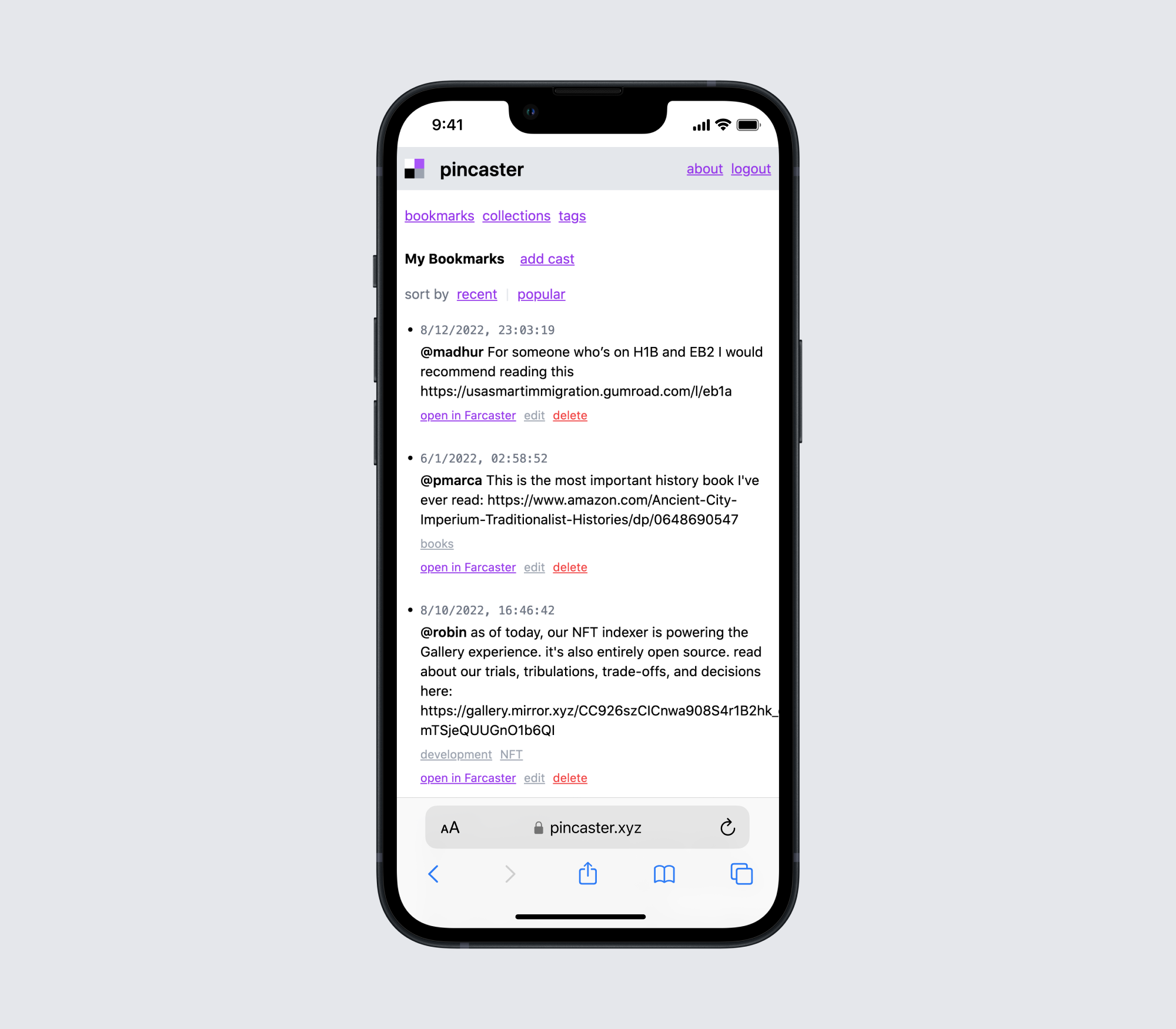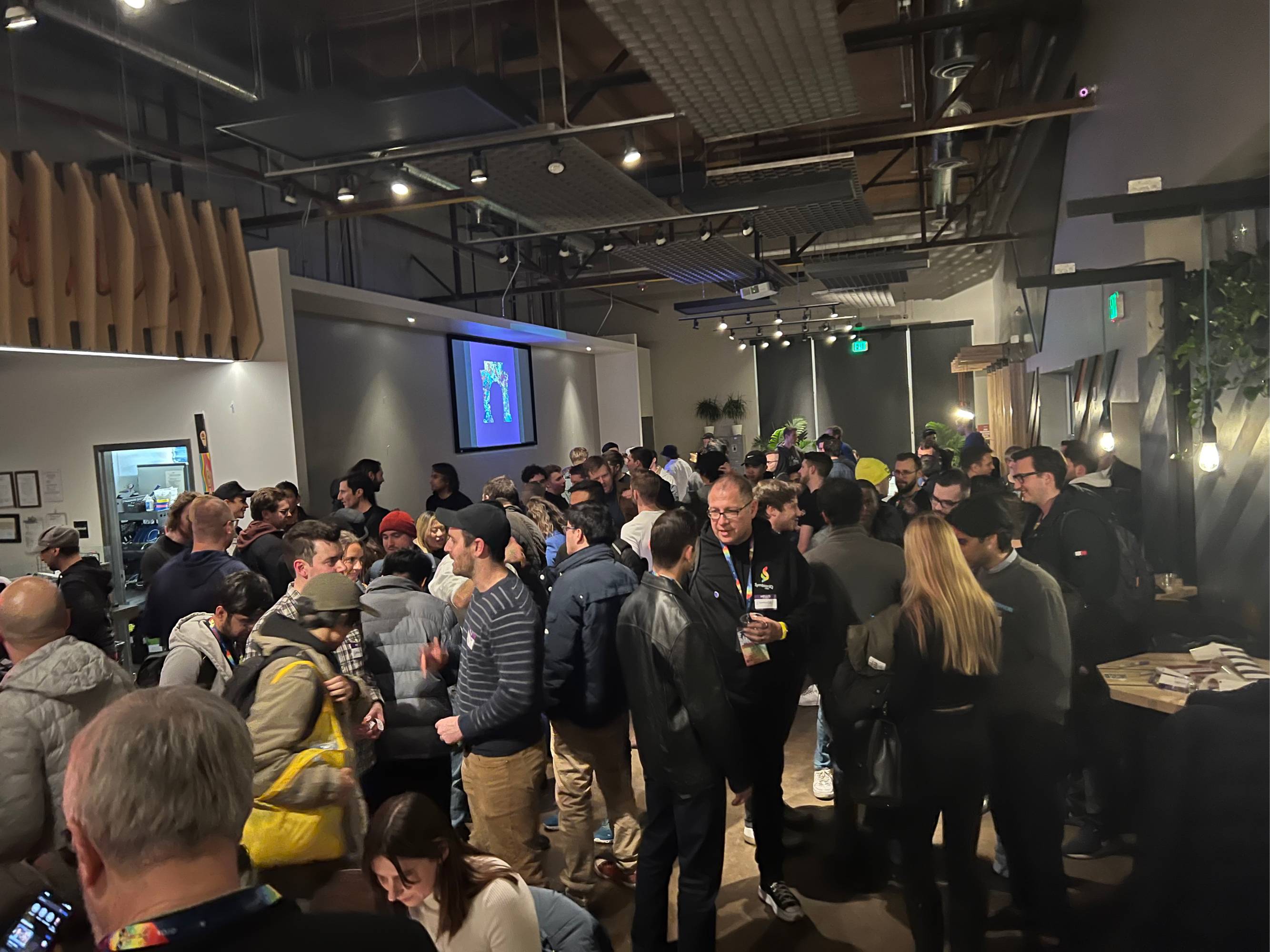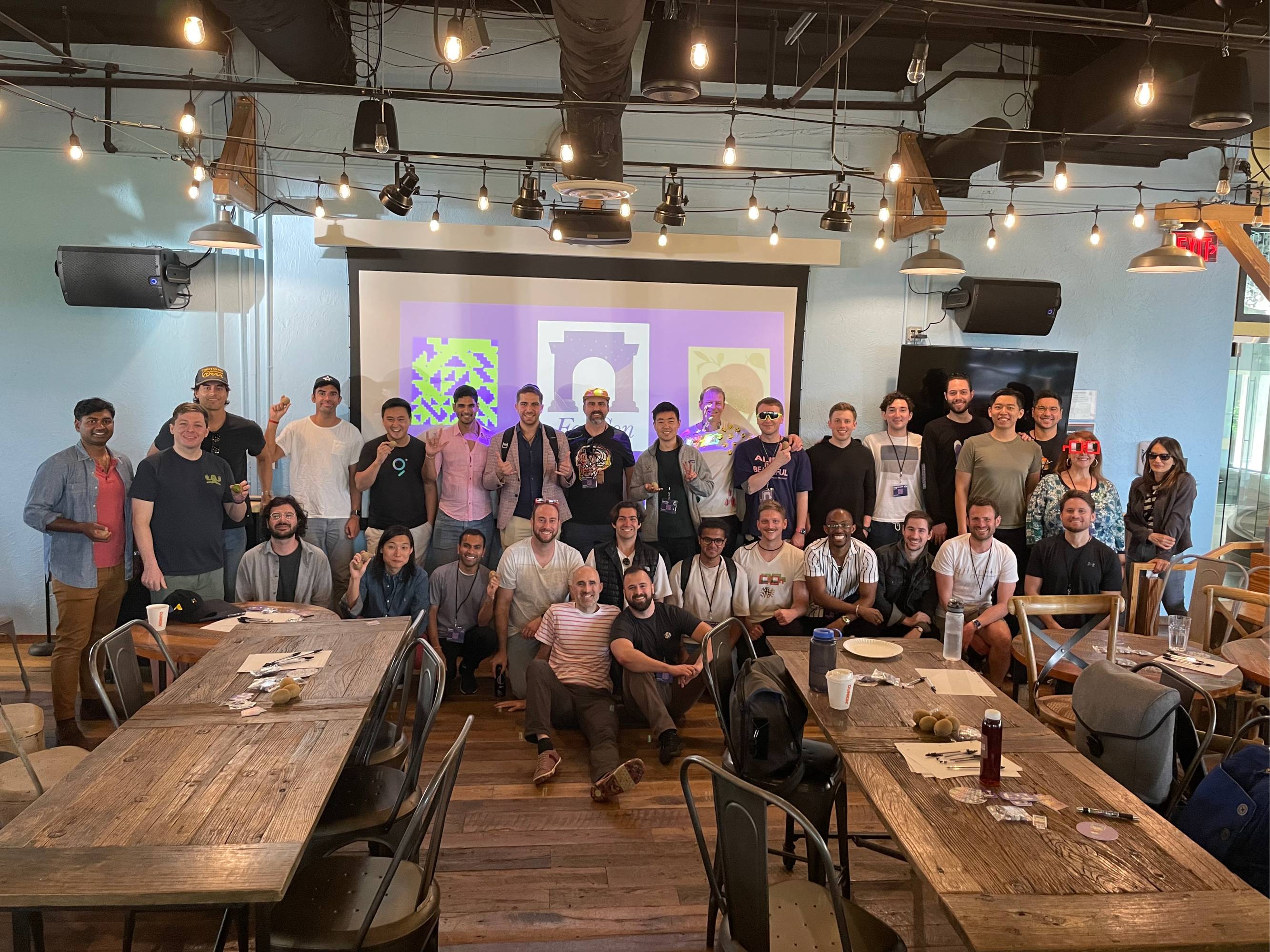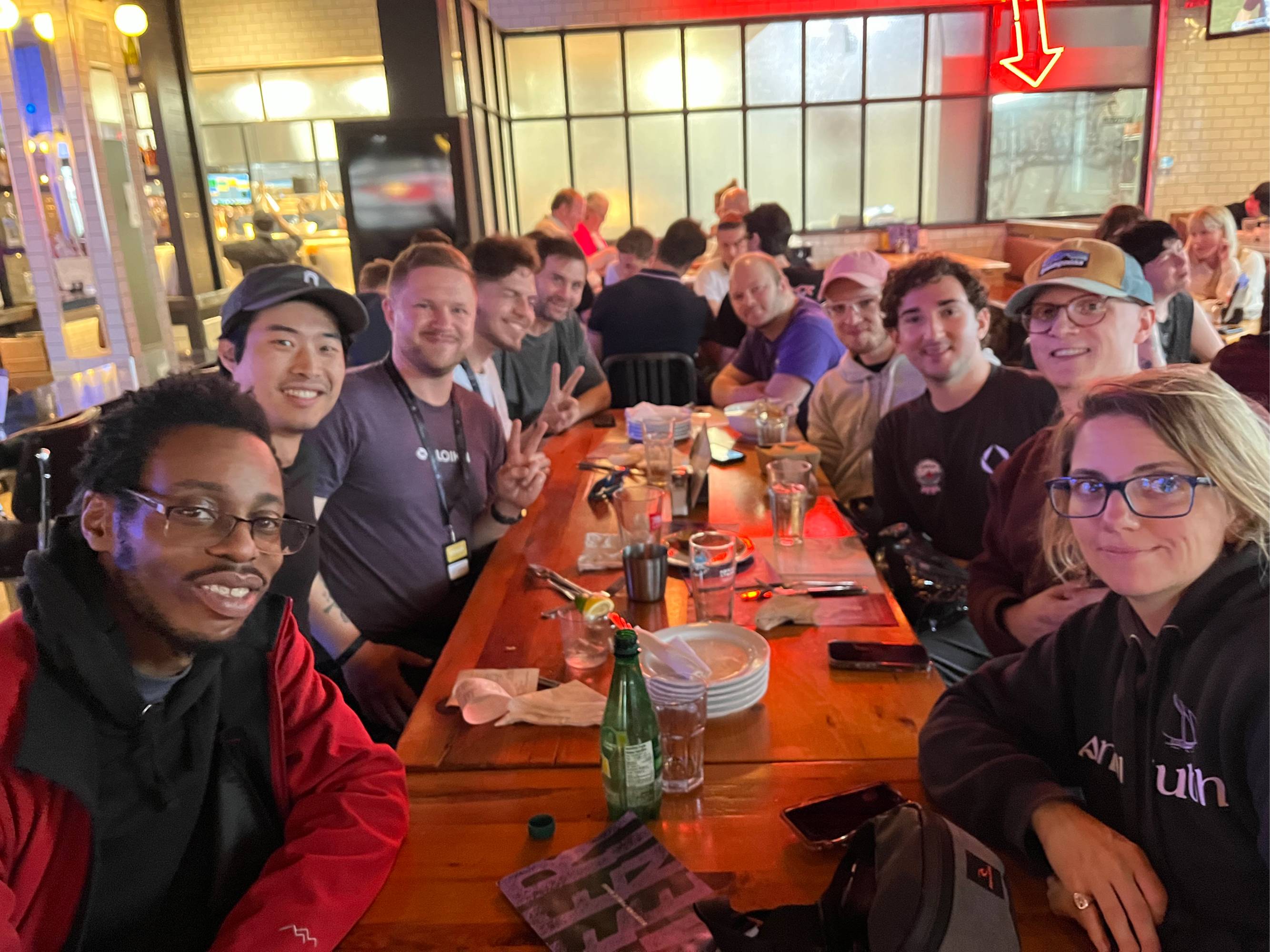I recently received an email notification that the domain name pincaster.xyz was set to expire on June 20 – it signified that I've been building Pincaster for a year, since the day I pushed the first commit, registered the domain and shipped the (embarrassing) first version of Pincaster to production.

I'm Carlos Matallín, (@matallo on Farcaster) a Software Engineer from València, Spain. I'm based in Toronto and am currently working on AI at Shopify. I'm also the founder of Pincaster, a discovery platform that allows users of Farcaster to save, share and explore interesting topics. Pincaster is a web service built on top of Farcaster, leveraging the permissionless nature of a crypto protocol and an example of composability, where we can combine distinct components to create new applications.
I wanted to share my personal experience as a solo builder in the crypto space over the previous year and to give a peek of some future plans.
What is Farcaster?
Farcaster is a protocol for building “sufficiently decentralized” social networks built by former Coinbase employees Dan Romero and Varun Srinivasan. I joined in June 2022, via Dan's invitation (Dan was personally onboarding every user until recently, when the team implemented an invitation system where existing users can refer new users – send me a DM if you want to join). Merkle Manufactury, the company behind Farcaster, the protocol, has received $30 million in funding from a16z and builds the official client Warpcast, which currently is the only way to onboard new users (until the protocol offers permissionless onboarding).
Farcaster is the main place where I've been playing the “Great Online Game” – to summarize:
Some of the most important things to take into account for The Great Online Game are: It is free to play, it is accessible to anyone, and its mechanics are exponential instead of linear.
Moving to a new country in the middle of a global pandemic, starting a new job and basically building my network from scratch has been very challenging during the past two years. Since then I've met new people who I can call friends today and started new relationships.
It's such a tired trope, but one thing that most users agree on is that it's the qualities of the people that makes Farcaster special: intelligent, kind and curious. The Farcaster community is mostly made up of builders, building directly on top of Farcaster or participating in one way or another.
In j4ck’s words, from his essay Farcaster: My Favorite Place on the Internet which at this point I feel I'm just repeating:
I realized how unique and special it was to be on the protocol during this time, and on the leaderboard, as it opened up channels for me I wouldn't get on any other platform.
My favorite part was I felt like I could be myself, and the conversation was focused on crypto, tech, and art – all my favorites.
Farcaster became my daily driver, I was hooked.
[...]
My perception of the core Farcaster user as of June 2023 is someone smart, kind, motivated, creative, curious, technically oriented, entrepreneurial, optimistic, and open to discussion.
This manifests itself in the timeline daily, where Casters raise interesting topics daily, have fun making memes, create NFTs, stream together, discuss products, discuss topical events, and ask a lot of questions.
[...]
There is no shortage of deep insight, founder support, investor opinions, and product feedback. In general, everyone is down to test everyone else's products and this hardcore early adopter attitude fosters a unique and rare environment.
"It is the ultimate scenius", like Adrienne writes in her essay The Power of Scenius: Farcaster and the Collective Genius of Communities:
Farcaster is full of creative geniuses, loosely organized around a common vision for a decentralized social network, bound by common values such as candor, intellect, curiosity, and truth. It is the ultimate scenius. And if it stays this way, it will unleash more innovation and inventions than can be imagined today.
There have been several Farcaster events where Farcasters hang IRL such as the Farcaster meetup at ETHDenver or FarCon in Boston. This past weekend I helped organize a Farcaster meetup in Waterloo coinciding with one of the global events around the Ethereum ecosystem.



Another Internet space where I've been spending a lot of time has been on Unlonely, one of the projects with the right amount of unhinged where like-minded Farcaster users congregate. I've also been having calls and meeting other builders directly to discuss their projects and share ideas, but for me it is an excuse to get to know other builders. It absolutely blows my mind that a year ago I hardly knew any of these people behind a monkey or a pirate jpeg. If you're reading this chances are that this also applies to you – this is a standing invitation: How can I help?
The Farcaster developer ecosystem: the key to the goal of 1 Billion Daily Active Users
The Farcaster strategy to get to the long term goal of 1 Billion DAU is using a Product-led protocol development. The premise is that high quality users will bring high quality developers that will bring high quality applications, creating a reinforcing loop:
Build the initial app and API to get the attention of developers
Attract developers that are interested in quality DAU
Get an ecosystem of thriving clients, applications and businesses on it
There has been a lot of discussion on how to get there between Farcaster founders and other independent developers of the Farcaster developer ecosystem as well as an exhaustive Farcaster activation analysis.
Farcaster monetization
The Farcaster monetization was originally based on the Protocol: with an optional $10 subscription a year for a username, and the Client (that goes to Merkle Manufactory): with a subscription model that will be introduced soon in order to prove that people actually want to pay for it.
There is a new proposal to make Farcaster usernames free and compatible with ENS https://www.youtube.com/watch?v=rc28VA2vbK0
Similarly to the Ethereum protocol, the nodes in the Farcaster network, called Hubs, store a copy of all data. Businesses and applications will use hosted clients instead of running their own Hub (like Gmail or GitHub for email and version control), in order to provide a service properly.
While Farcaster is currently free there’s a small barrier of entry. In my case, the monthly bill for infrastructure costs alone exceeds $8 that would cost a Twitter subscription.
Chris Dixon, a prominent Farcaster and partner at a16z, eloquently stated, "What the smartest people do on the weekend is what everyone else will do during the week in ten years". I have dedicated countless weekends and waking hours to working on Pincaster.
I firmly believe in the mission of Farcaster and recognize the importance of decentralization and permissionless innovation. When I initially learned HTML by inspecting source code and built my first website, I did not ask for permission.
But the hard truth is that Farcaster is an expensive hobby.
Developer experience and ongoing issues
When it comes to getting distribution for Pincaster, it often feels like a challenging uphill battle, especially considering the bias in the smart defaults of Warpcast, the client. It could also be highly beneficial for developers, users, and ultimately the Farcaster core team to enhance developer relations and improve communication, particularly regarding breaking changes. There seems to be a significant tolerance for such changes, which most of the time are initially adopted and announced in the client.
A recent specific example at the time of writing this piece are attachment and embeds fields, that have not been updated on the documentation and broke existing integrations.
One of my biggest sources of frustration is the stated preference of users who claim they would use a feature that I’ve previously built but their revealed preference is different. It's possible that I simply need to improve my efforts in promoting Pincaster.
Builders of Farcaster
You can find an exhaustive list of other projects built on Farcaster in the Awesome Farcaster repository.
Airstack, Fabric and Highlight are some examples of remarkable projects that I've been following closely and deeply admire. They're not strictly built on Farcaster, but their founders Jason Goldberg, Jonny Mack and Nat Emodi are active members of the Farcaster community.
Two other builders who consistently showcase progress and actively build in public are Tim and Dylan. In Dylan's case, he is leading the way in innovating the FIP-2 space, which is one of the most fascinating recent aspects of the protocol. As Cameron Armstrong puts it in his essay The Universe is a Joke, "FIP-2 makes everything Content-ifiable."
After conducting a poll prior to the first anniversary of Pincaster, it became clear to me that I was not shilling hard enough, and many people were unaware of what Pincaster truly is. That's something I'm actively trying to change, and this essay serves as an example of my effort, starting with a review of how it started.
If you have any feedback or suggestions, feel free to reach out to me directly on Farcaster or Telegram.
Special thanks to Andrew for helping with editing this and who I couldn’t be more grateful for.